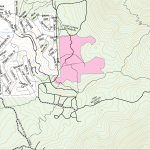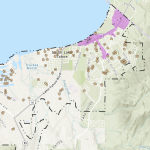Hazing bears helps minimize conflict, according to CDFW and BEAR League
SOUTH LAKE TAHOE, Calif. – With current human-bear conflicts this summer, including the break-in at Camp Richardson and the highly contentious bear #753, it’s no wonder that bears are on the mind for many in Tahoe. “Hazing”, or the practice of scaring bears to make them averse to humans, is one of the more effective ways to prevent conflicts according to both local bear advocates and the California Department of Fish and Wildlife (CDFW).
Black bears are plentiful in California: 60,000 of them reside in the state and approximately 500 of them make the Tahoe Basin their home. But with the residents’ proximity to the wilderness and the high numbers of tourists that come through the area, it’s no wonder bears come into contact with humans, and often become acclimated to them.
Trash, pet food and even tourists baiting bears for a photo opportunity—all of these food sources make it appealing for these bears to enter human communities and forage there. Worse yet, because these large omnivores teach their cubs, the same behavior gets reinforced and rewarded by irresponsible people.
Unsecured homes, campsites and cars with food sources can be targeted by bears, and they do often enter or even break in to get an easy bite to eat.
Plus, neighborhoods often offer a haven for bears during the winter. While they do have to contend with the threat of traffic, it can often be safer to make a den under someone’s house than in the wild, where they compete with other bears and wild animals.
Ann Bryant, executive director of the BEAR League, says that she’s observed mother bears come into neighborhoods throughout her 30 years of working with bears. “They all act like this when they have cubs. They’re safer in neighborhoods from coyotes and male bears who will eat their cubs,” said Bryant.
But Bryant asserts that it is a human problem, not a bear problem, that has aggravated the human-bear conflict. “We live in their country, we are responsible for fixing this problem.”
Alexia Rodding, Tahoe bear specialist at the CDFW, says hazing is one of the major ways to avoid human-bear conflict. “We want to scare them and make them feel like interacting with humans isn’t rewarding and is frightening.”
In general, when hazing a bear:
- Keep a safe distance
- Scare the bear away from properties and towards wilderness, like forests or meadows
- Make the interaction unpleasant: yell and stamp your feet, use a paintball gun or throw pinecones
- Do not use food during a hazing experience
- Once the bear is scared away from properties, do not chase the bear and harass it further
- Secure all food sources and check for property damage
Rodding said, “I highly recommend using a paintball gun if bears are on your property, as it ensures a safe distance between you and the bear as well as making actual contact with the bear.”
Bryant has said the BEAR League has seen success with throwing pinecones and yelling at the bears as well.
Rodding says that airhorns, which are used in other places to haze bears, aren’t as effective here because the bears are used to hearing cars, dogs barking and other urban sources of sound—so they’re not as frightened.
The BEAR League often has volunteers called out to neighborhoods to frighten bears into meadows or greenbelts. Rodding says that if you spot a bear in a greenbelt and it is not actively making contact (i.e. is up in a tree or simply walking through), you do not have to haze the bear—in fact, it could be considered harassment if the bear is not approaching you. However, you can haze the bear if it begins to come near you or is on a path that people often use.
To prevent bears from entering your home, both Bryant and Rodding recommended the use of bear mats or bear wires, which deliver an electric shock. The pain usually disincentivizes the bear from getting in, without causing long-lasting damage.
The CDFW can provide loaner electric mats to protect entryways around your home if you’re waiting on a repair or for the shipment of your own bear mats.
And before hazing becomes a necessity, following BearWise guidelines can prevent bears from coming into your neighborhood or campsite at all. Both the CDFW and BEAR League advocate for BearWise’s tips, which you can read at https://bearwise.org/
Eli Ramos is a reporter for Tahoe Daily Tribune. They are part of the 2024–26 cohort of California Local News Fellows through UC Berkeley.

Support Local Journalism

Support Local Journalism
Readers around the Lake Tahoe Basin and beyond make the Tahoe Tribune's work possible. Your financial contribution supports our efforts to deliver quality, locally relevant journalism.
Now more than ever, your support is critical to help us keep our community informed about the evolving coronavirus pandemic and the impact it is having locally. Every contribution, however large or small, will make a difference.
Your donation will help us continue to cover COVID-19 and our other vital local news.










